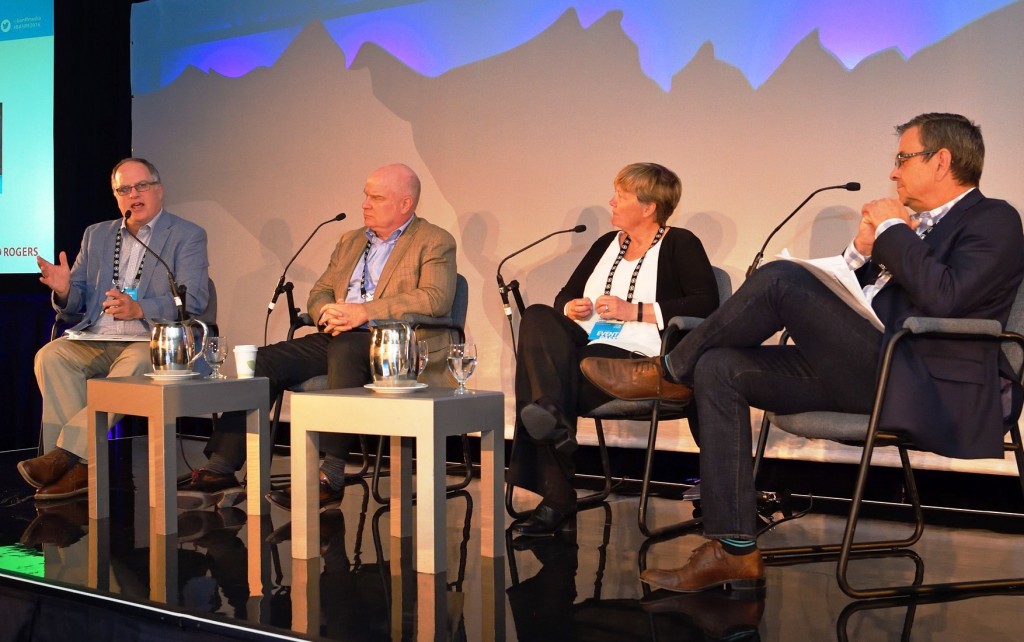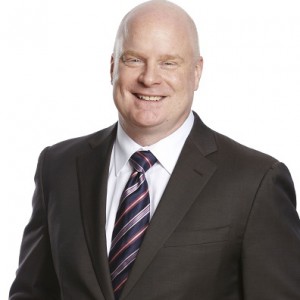 Banff, Alta– The second panel I moderated at Banff was “Broadcasting the 4K Way.” The panelists were Mary Ellen Carlyle, SVP & GM of Dome Productions, Scott Moore, President of Sportsnet and head of all things NHL at Rogers and my cousin Ken MacDonald, GM & VP of Discovery Canada.
Banff, Alta– The second panel I moderated at Banff was “Broadcasting the 4K Way.” The panelists were Mary Ellen Carlyle, SVP & GM of Dome Productions, Scott Moore, President of Sportsnet and head of all things NHL at Rogers and my cousin Ken MacDonald, GM & VP of Discovery Canada.

MacDonald, who I’ve been interviewing since he ran things at Global News, is related, through marriage, to my cousin Maureen Brioux-Macaulay. It’s complicated: whenever two Brioux’s meet, it takes half an hour to figure out how we’re related.
There was no favoritism for family members on the panel, however. Moore, in fact, makes Don Cherry look shy when you put him close to a mike.
Scott did, however, heap all praise on Carlyle, who has really pioneered the coverage of live sports in 4K in Canada. She and her team at Dome tricked out the trucks, converted the cameras and lashed together the editing banks. She was given just four months to make 4K happen on Sportsnet.
Carlyle is also a diplomat. As she puts it, she’s neutral like Switzerland, able to work with and also reign in both Bell and Rogers.

Interesting story: Carlyle says Dome came about because, many years ago, then CTV boss Ivan Fecan and Ted Rogers had lunch and hit upon the bright idea of splitting the technical costs when it came time to introduce Hi-def. Now Carlyle is still working for Bell and Rogers, starting with basketball games back in January. It’s a bit of a jump ball as to who went first–Sportsnet or TSN–and now with The Blue Jays and the NHL.
advertisement
Discovery, early converts to Hi-def, offer a 4K channel featuring Shark Week goodies as well as River Monsters and Jade Fever on their Discovery GO app. TSN will also start offering CFL games this season in 4K, thanks to Carlyle’s magic.
I spoke with a Corus executive Tuesday who said they’re in no rush to go 4K. CBC’s Bob Kerr was in the house and said while there’ll be no 4K of the upcoming Rio Summer Olympic Games, the public broadcaster will probably be 4K by the time Korea rolls around. (Carlyle had heard NBC will provide some 4K coverage of the opening ceremonies, which will be tape-delayed.)
Even Moore and MacDonald admitted the penetration is pretty low so far. When I spoke with network sports officials at CBS last January, they said 4K just hadn’t reached critical mass enough for them to convert the 70 cameras that cover the Super Bowl to the new technology.
Other innovations, such as 8K and VR, are around the corner. Carlyle believes 4K won’t be just another 3-D TV fad, however. She wasn’t sure Samsung–the world’s largest manufacturer of TV’s–still even makes plain old Hi-def sets.

The price of 4K sets have dropped dramatically. One year ago, I was invited to test an 88-inch SUHD 4K Samsung set. The super-thin, curved screen was listed at the time at $30,000. Now retailers have 50+-inch 4K babies going for just a few hundred more than you’d expect to pay for Hi-Def. The other drawback then was there was nothing to watch. Samsung provided Blu-ray movies for the test, and one golf clip. I did watch a regular Hi-def broadcast of True Detective and, yes, Hi-Def does look better on a 4K screen.
Is it worth it? The pictures are sharper, brighter and boast eight times the amount of colours. Sports events such as golf and hockey look amazing in 4K. Even Moore, however, acknowledges this isn’t for streaming off mobile devices. You need a big set to really enjoy the innovation.
Moore did a killer impersonation of Rogers CEO Guy Lawrence, claiming it was the Brit who wanted 4K to keep up with the BBC (who really didn’t have it yet). The real reason Rogers and Bell are motivated to get fully into the 4K game, as Moore candidly admitted, has everything to do with the extra capacity it will take to bring 4K pictures into your home theatres. Extra capacity means buying a more expensive cable plan. When 4K comes to America, it will likely be Comcast/NBC in the lead.
That sound you just heard was pennies dropping.






